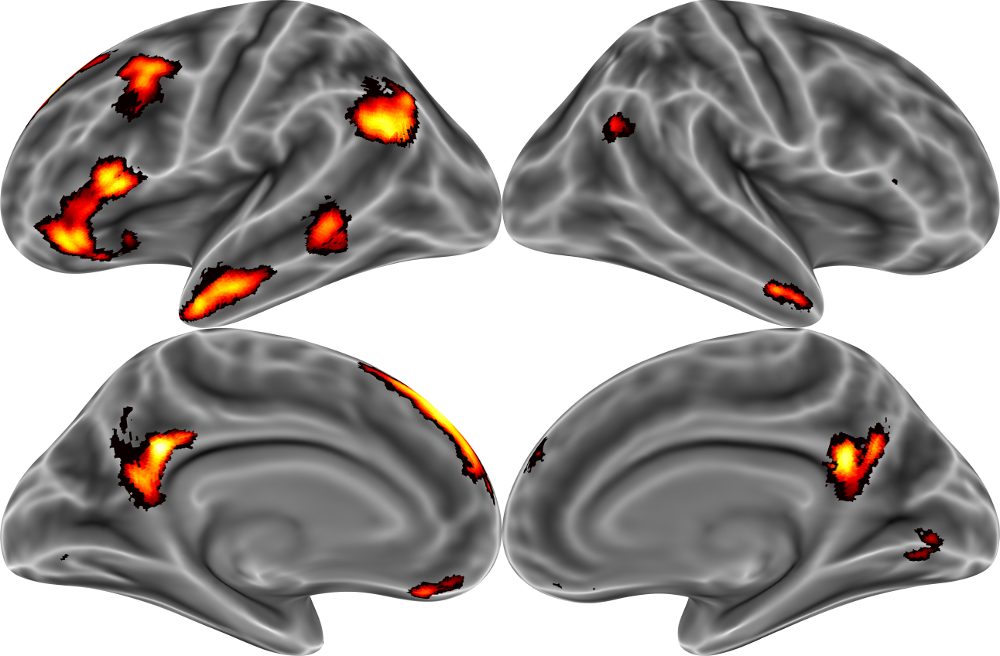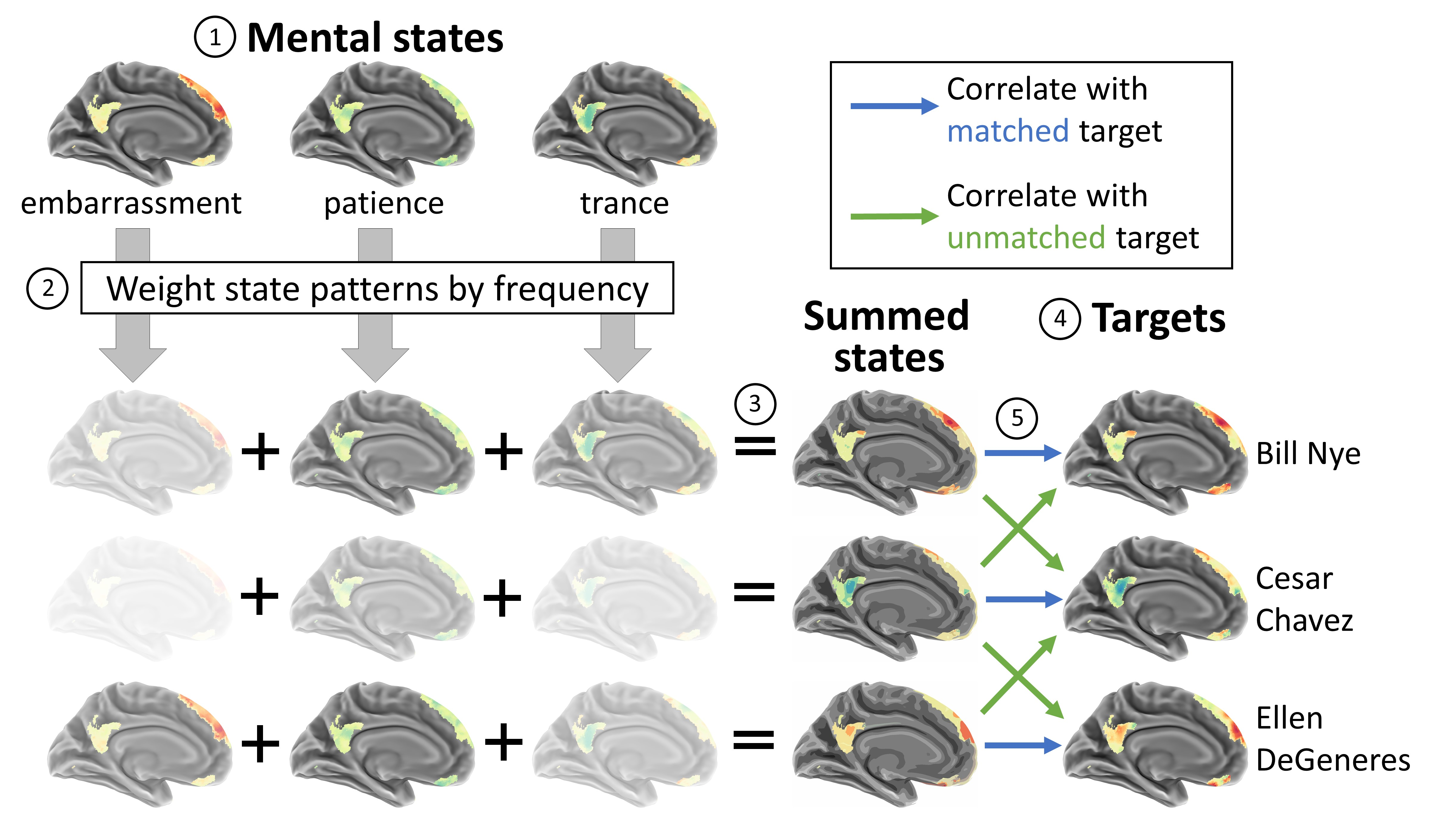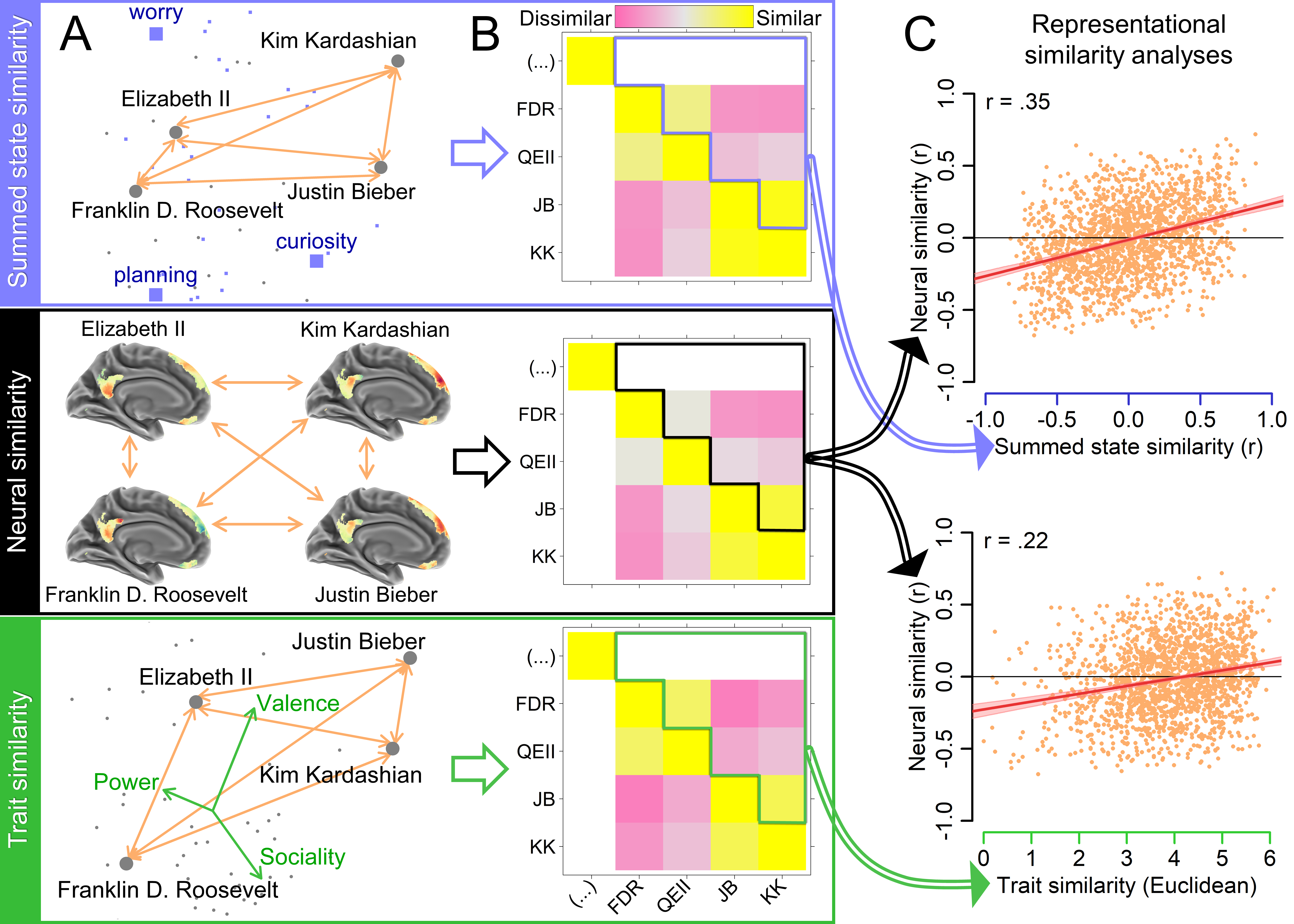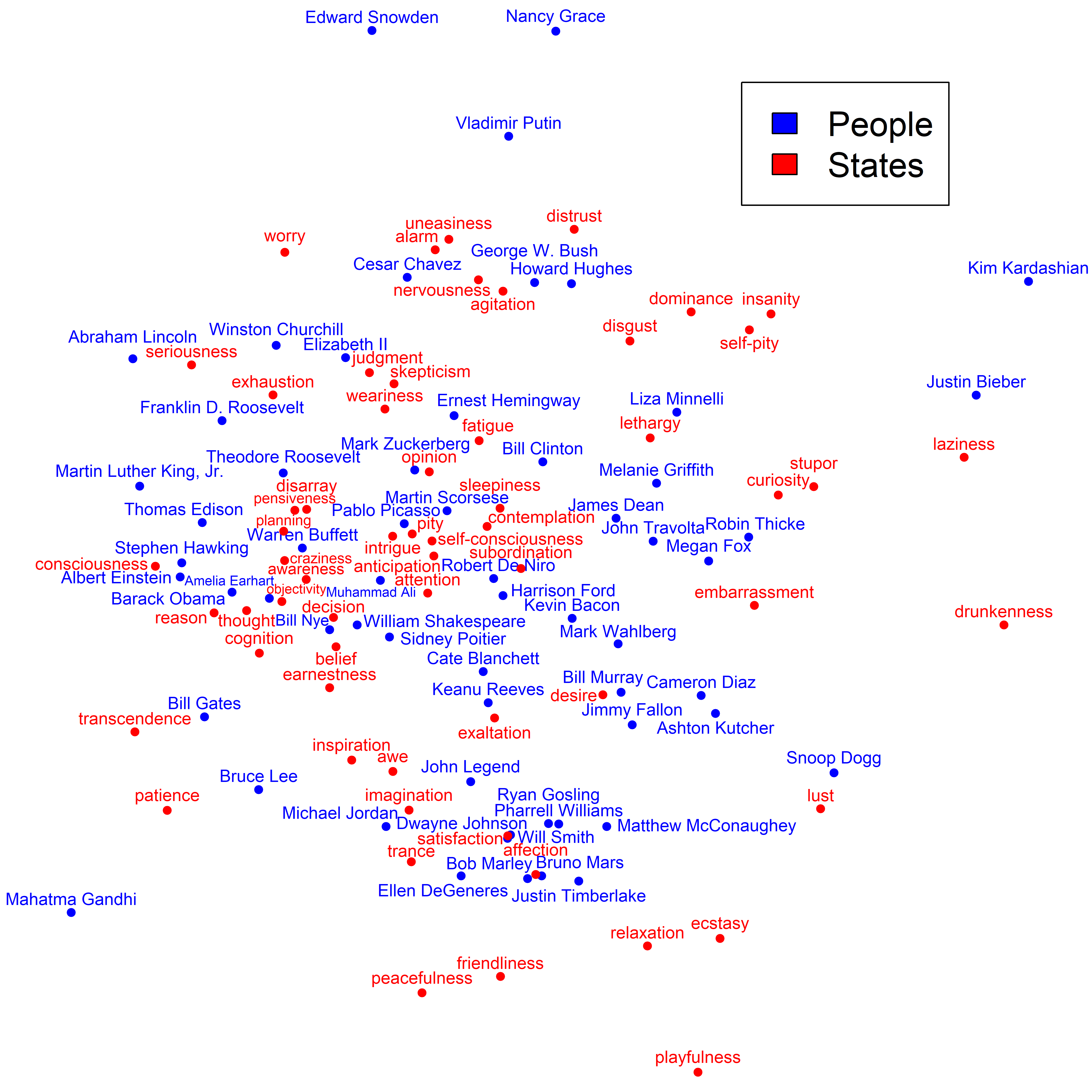Postings on science, wine, and the mind, among other things.
The brain represents people as the sums of their states
Pop summary of Thornton, Weaverdyck, & Tamir (2019) Nature Communications

If you were asked whether Bill Nye would like to learn karate, or whether Ellen DeGeneres likes air travel, how would you go about answering? Maybe you'd try to look up the answers online, but let's say that you didn't have internet access. Instead, let's imagine you were lying in a dark, loud metal tube, answering dozens of these questions. In fact, that's exactly what participants in one of my previous studies did, for over an hour each. They took part in this rather odd task to help us understand more about the way the brain represents other people.
When we need to make an inference about a person's desires, beliefs, or preferences in everyday life, we don't always have access to the exact right answer. For example, if you're trying to decide whether to take a friend on a surprise trip to the beach or to the mountains, you may never have heard them explicitly express a preference between these two options. However, even when we don't know the answer to a specific question, we often know a great deal about the person in question. Among other things, we have likely formed some impression of their personality or disposition: the enduring traits which make them similar to or different from other people. We can use this general knowledge about a person to make educated guesses to answer specific questions about them. For instance, if you think that your friend is quite introverted, and dislikes being in crowded places, perhaps they might prefer the seclusion of the mountains to the bustle of the beach.
In my previous research on this topic, I found that people do seem to activate trait knowledge when prompted to make social inferences about others. In particular, we found that patterns of brain activity within brain regions associated with social cognition (shown below) could be predicted based on the perceived traits of the different people participants answered questions about. Three main traits - synthesized from existing psychological theories of person perception - explained about two-thirds of the reliable activity in these brain regions. These traits were power - the perceived dominance and competence of the target person - valence - whether a person is perceived as positive or negative - and sociality - how much that person likes to engage with others socially.

Brain regions with reliable activity associated with thinking about different people.
This research got me thinking more about the nature of (perceived) traits: what are they, and where do they come from? Traits differ from one another in a variety of ways. For example, some traits are expressed much more obviously than others, making them easier to infer. However, the type of trait which I homed in on in this case was related to my other research on the topic of mental states (read more here, here, here, and here). Mental states - others' momentary thoughts and feelings - are often contrasted with traits because states are fleeting whereas traits endure. However, a subset of traits are very much routed in states. These traits reflect people's habitual affect - the mental states which they experience with chronically high frequency. For example, if you think someone is frequently happy (a state), you might call them a "happy person" (a trait). The existence of such traits suggests a close link between the states we perceive people to experience, and the personality or disposition we attribute to them.
This line of thinking led me to a hypothesis: if we use traits based on habitual states to understand other people, then perhaps the brain represents those people as the sums of their states. I tested this hypothesis in my latest paper, now out at Nature Communications. Fortunately, I already had a number of data sets which I could combine to help answer this question. In two previous studies, I had collected patterns of brain activity associated with thinking about particular mental states (trance, embarrassment, planning, etc.), and in the study described earlier in this post, I collected patterns of brain activity associated with particular target people. I realized I could test my hypothesis by adding up the state patterns in the right ratios (i.e., based on the frequency) to produce person-specific patterns. All I really lacked was information about how frequently each of the target people experienced each of the mental states. To fill in this gap, I had a large sample of participants on MTurk rate the frequency with which they thought each of the 60 famous individuals experienced each of the 60 states. I could then take a weighted average of the state patterns depending on the relative frequencies with which each target experienced those states (see schematic below). If the results of this averaging process resembled the actual patterns associated with each target person, this would support the summed state hypothesis.

To assess the accuracy of the summed state pattern reconstructions, I correlated them with both the actual person pattern they were matched to, and all possible unmatched patterns. Thus, for instance, the reconstructed Bill Nye pattern would be correlated with the actual Bill Nye pattern, and also with the patterns from the other 59 target people. If the matched correlations were greater than the unmatched correlations, this would indicate that we could accurate and specifically reconstruct person-specific patterns from summed state patterns. This in turn would support the summed state hypothesis.

As you can see in the graphs above, the results of this procedure did indeed indicate that pattern reconstructions were more correlated with matched versus unmatched person patterns. The individual (solid) points in the graphs each represent one participant in the famous person study I outlined at the beginning of the post. The same 29 participants are shown in the matched and unmatched conditions, and with respect to reconstructions based on the two different mental state studies. The averages of each condition (circles with white centers) are shown with 95% confidence intervals. The data from both studies indicated a clear difference between the two conditions. This outcome was further supported by the results of additional modeling techniques which I won't get into here (see the paper for the gritty details).
These data indicate that the brain does indeed represent other people at least in part as the sums of their states. However, how do these summed states compare with other traits in explaining the way we think about people? To answer that question, we carried out a number of additional analyses. These analyses were all forms of representational similarity analysis (RSA), a way to compare similarities to other similarities (see here for an earlier blog post describing them method, or here for a tutorial on how to do it yourself).
First, we computed the similarities between the 60 target people according to each of two models: 1) their summed states, and 2) their locations on three trait dimensions synthesized from major theories in the psychological literature. We then used RSA to compare each of these two different models to some criterion. We used five different criteria to ensure that our results generalized across different methods and measures. They included the similarity between patterns of brain activity (shown below), Mturk participants' explicit ratings of how similar the famous people were to each other, the semantic similarity of the famous people's Wikipedia biographies, and choices and reaction times from this experiment on my research platform, MySocialBrain.org.

What we found across all five measures was that summed states offered a better explanation of interpersonal similarity than did the other traits. This isn't to say that the other traits didn't work at all - they were actually extremely robust predictors of interpersonal similarity - it only means that the summed states were even better. In fact, the summed states completely explained away the predictive power of traits with respect to two of our measures: textual similarity of Wikipedia biographies, and reaction times in the task on MySocialBrain.org. Together these results provide evidence that summed states are not just some marginal contributor to the way we think about other people, but are rather an explanation for much of person perception.
Although we tried to take a comprehensive approach to testing the summed state hypothesis, this research presented here still has some limitations. The most serious - to my mind - is the fact that we focused entirely on famous target people. We did this primarily for methodological reasons. Specifically, famous people are very convenient because they are common referent points across participants. That is, different participants will all be familiar with these well-known individuals. This contrasts with personally familiar individuals like friends and family. Studying personally familiar others may have more validity for explaining how we think about people in everyday life. However, since each participant knows a different set of personally familiar people, there is no way to distribute data collection across multiple participants. Thus, to do the research we did here with respect to personally familiar individuals, we would have had to have each participant engage in each separate task. This would have entailed about five hours in the fMRI scanner, plus another whole day of making behavioral ratings. We turned to famous target people in large part because we didn't want to inflict such an arduous slog on our participants. However, future research should aim to test our findings in personally familiar others or with artificial target people (constructed biographies) to ensure that the results we see here generalize to such targets.
So, what do people look like in the world of summed states? You can get an idea by taking a look at the figure below. This graph was generated based on participants' ratings of how often each target person experienced each of the states. These ratings were subjected to a statistical procedure called correspondence analysis, meant to analyze co-occurrences. The result is a 'map' of social space, which shows both mental states and target people in the same space. The locations of the people are determined by which states they experience most frequently, and vice versa. Thus, for instance, you can see the famously reclusive billionaire Howard Hughes appropriately placed near the state of distrust, and so forth. The placement of the people doesn't necessarily represent their lived reality, but it does represent how people perceive them. You'll also notice that similar people are often placed close together. In this graph, that is purely a result of those people experiencing similar habitual states.

I hope you've enjoyed this peek into my latest research on how we think about other people. Stayed tuned for more research applying these techniques to similar questions, such as how we think about the social situations we encounter on an everyday basis!
© 2019 Mark Allen Thornton. All rights reserved.